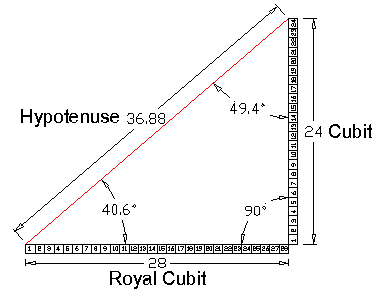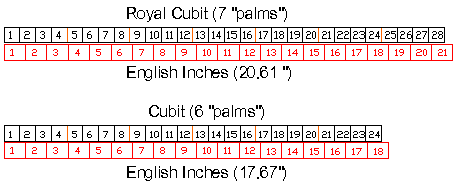Chart 1.
The ratios of the three sides from the right-angle triangle, formed by
the two cubit measures.
The ancients were renown for their astronomical studies, and understood
the harmonious motions of their wondering gods, the planets. From the
above chart, there is one ratio most commonly known to astronomers, the
distance ratio of Mars compared to Earth when measuring their average
distances from the Sun (1.523). This ratio instigated a closer view of our
neighboring planet Mars with respect to Earth.
3. Comparing the triangle formation with the planets Earth and Mars.
Many remain steadfast in their belief that the ancient Egyptians were
not aware of planets orbiting the Sun, but it is here where this issue
should be put to rest.
In the approximate year of 560 BC and 1633 AD (note 2100 years
separation), two distinguished individuals were sentenced to house arrest
until their dying days. Their crime committed was to teach their beliefs
that Earth and the "wandering gods" orbited the Sun. Their names….
Pythagoras and Galileo!
Planet motion around the Sun had been common knowledge for several
millennia, yet the religious sector failed, or refused to understand the
workings of the cosmos.
The ancient Egyptians acclaimed the stars as "gods" and the
orbiting planets "wandering gods". Their fortune or misfortune
depended on what "wandering" god(s) was passing/visiting the
stationary gods. To rephrase into our terminology…the ancients lifestyle
depended on what planet(s) aligned with stars, a system that many continue
to rely upon in this modern world of ours; we define it as astrology. We
simply changed the title "god" to star, and the name
"wandering gods" to planets; unfortunately we tend to forget the
source for the word "planet" . "Planet" is derived
from Greek, meaning "wanderer", therefore we observe wanderers;
identical to the ancients…nothing has changed!
It is a fatal error for us to believe that all planets are similar to
Earth only because they orbit the Sun. The four large outer planets:
Jupiter, Saturn, Uranus, and Neptune have been monitored, indicating they
giving off more energy than they receive from external sources. Therefore,
by definition, these four larger gaseous planets could be called suns, and
a sun is a star, therefore the four large outer planets are wandering
stars. The ancient Egyptians were correct…we have judged incorrectly!
Since the ancients were religiously dependant upon their wandering
gods, they studied and measured their daily motion in the heavens; it was
the most logical thing to do. They needed to know how often their
favored/feared planet would return, or meet with other planets. We shall
learn, they counted the days and measured with stunning accuracy.
Using the two cubit measures, they are now placed upon the orbital
paths for Mars and Earth (Ill. 3).
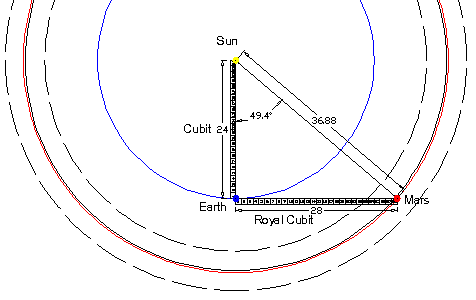
Illustration 3.
Comparing the right-angle triangle, formed by the two cubit measures,
to the orbital locations for Earth and Mars
The above illustration has the cubit (24 fingers) representing the
average orbital distance Earth is from the Sun (blue circle). From this
location, the royal cubit (28 fingers) measures horizontally to the
average distance Mars is from the Sun (red circle). The solid black circle
represents the actual "average" distance to Mars, while the
inner and outer dashed circles represent the minimum and maximum distance
Mars is from the Sun.
4. The calculated location where Mars and Earth would align.
The two cubit measures indicate the orbital paths for Earth and Mars,
but supporting evidence must be established to strengthen the possibility
that the ancients were knowledgeable astronomers. We should realize that
if the ancients fully understood planet distances, then they certainly
knew their individual orbital periods.
In 1609 AD, German astronomer Johannes Kepler introduced to the world
of science his third law of motion. Simply stated; the cube of the
distance ratio, from one planet to the other, is directly proportional to
the square of their period of orbit….In laymen terms, if you know how
far a planet is from the Sun, then you can calculate how long it requires
for that planet to orbit the Sun.
Earth orbits the Sun in 365.25 days while Mars requires 686.97 days.
From the previous diagram, the angle formed by the two cubit measures is
49.4 degrees, using Kepler’s third law, Earth must travel 105.48 degrees
to "catch up" to Mars…Earth and Mars align with the Sun at
this location (Ill. 4).
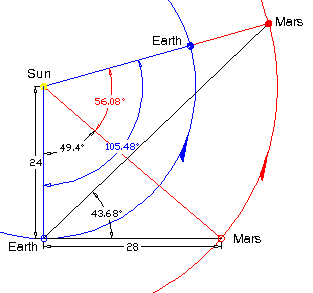
Illustration 4.
Using Kepler’s third law of motion, Earth and Mars will align at
the location indicated. Earth orbits 105.48 degrees around the Sun to
align with the slower planet Mars, the latter only traveling 56.08
degrees along its designated course.
For the first time, there is evidence indicating these measures being
involved within the pyramids at Giza and Dashure.
During the Egyptian III and IV dynasty, there were several pyramids
built, other than those at Giza. One pyramid in particular is the
"North" pyramid at Dashure. The oddity of this structure is the
low angular slope chosen in the design; its measure is 43.68 degrees. From
the above illustration, we can see the identical angle formed when a line
is drawn from the initial start position of Earth to the alignment
position of Mars. For those who may attempt to dispute this claim, they
must first provide the true reason why the ancients elected to build the
north pyramid at such a low angular slope….unknowingly, the answer has
always been visible in the heavens; the direction the pyramids point
toward.
Egyptologists now realize the ancients having understood the ratio
of the circumference of a circle to its diameter, also known as the
number pi, and many admit the two large pyramids at Giza have distinct
side ratios, those being 4/3 and 4/pi. Using the cubit and finger of
measure, the 4/3 ratio is expressed as a 1:22 sekhed (1 cubit to 22
finger ratio), while the 4/pi ratio is a 1:21 sekhed (1 cubit to 21
finger ratio). From this, we can now compare the ratios for the two
large pyramids to each other, they produce a secondary ratio equal to
21/22, and this reduces to 3/pi.
Comparing the sloped sides of the Giza pyramids produces a 3/pi
ratio, and the North pyramid at Dashure is built on a 43.68 angle, or
3/pi ratio !!…This is sufficient evidence to indicate the ancient
Egyptians being advanced in trigonometry and they implementing an
ingenious means to demonstrate the orbital motion of Earth compared to
Mars at two separate pyramid sites.
5. The introduction to Venus and the numbers 28 and 62.
Although it appears intriguing that both the cubit and royal cubit were
possibly used to determine the orbital location for Mars, there had to be
a secondary motive behind the design.
The closest distance between Mars and Earth is approximately 55 million
km, however, Venus is closer in measure (39 Million km), and orbits
between Earth and the Sun. The average distances from the Sun, for the
planets Venus, Earth, and Mars are 108.21, 149.6, and 227.6 million km
respectively.
When using the royal cubit and cubit to indicate orbital locations for
Earth and Mars, the 24 finger cubit represented the distance Earth is from
the Sun. Using the above information, then the distance to Venus would
equal 17.36 fingers (108.21x24/149.6). Illustration 5 now shows the
orbital path for Venus.
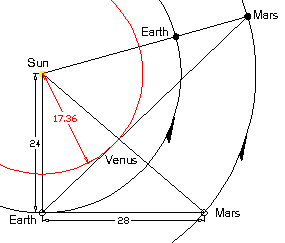
Illustration 5.
The introduction of our inner planet Venus (red circle) and its average
orbital distance from the Sun.
The diagonal line, drawn from the previous illustration, is perfectly
tangential to the orbital path of Venus; a truly remarkable feat,
indicating the ancient’s full knowledge of planetary motion and orbital
distances from the Sun.
Although these results are totally amazing, there are two other
dimensions to be presented.
Drawing a line from the Sun and perpendicular to the line from Earth to
Mars produces a right angle triangle having angular measures equal to 62
and 28 degrees respectively (Ill. 6).
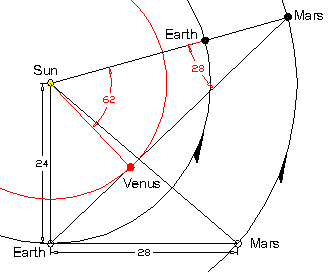
Illustration 6.
Earth, Venus, and Mars align forming a triangle having 62 and 28
degrees angles.
From illustration 6, the two angles formed are 62 and 28 degrees, and
we are aware of the 28 fingers to the royal cubit. But it is the second
angle that is most important.
…An angle, measuring 62 degrees, has a tangent ratio equaling 1.8807,
and the most remarkable coincidence is the planet Mars… it orbits the
Sun 1.8808 Earth years!
6. A final examination of the two cubit measures.
The previous notes have demonstrated the orbital locations for Earth
and its neighboring planets, and a possible reason for the ancients to
create the royal cubit having twenty-eight fingers, and the cubit with
only twenty-four. But within these instruments is at least one additional
measure to be noted.
It was mentioned how the ancients used the royal cubit and fingers to
create any angle they preferred, Egyptologists use the term sekhed.
However, there appears to be a disagreement explaining how this technique
was incorporated for building the ancient pyramids. Many believe that only
whole finger measures were compared to the royal cubit to form the desired
angle.
e.g. A 4/3 ratio is equal to (1 cubit)/(22 fingers), or a 1:22 sekhed
measure. This system would be adequate for standard triangular designs,
but most inadequate for precise astronomical measure. The ancients had to
include their knowledge of celestial motion, and designed within both
types of cubits the orbital period for Earth, Mars and our closets object,
the moon.
The sidereal period for the Moon is 27.322 Earth days; this number was
marked on the length of the royal cubit. From this location a line is
drawn to the end-point of the short cubit, forming a 48.71 degrees angle
(Ill. 7).
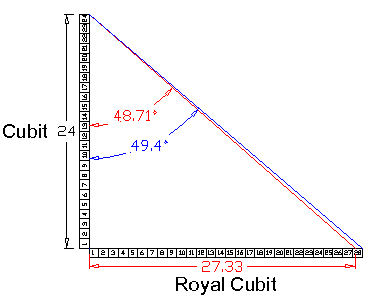
Illustration 7.
Using the finger measure of 27.33 to represent the orbital period of
the Moon, the ancients then drew a line (red) to the end of the short
cubit, forming a 48.71 degrees angle.
We no longer show interest or concern in planet observation, and we are
not expected to reason why the importance of the 48.71 degree angle. Today’s
Egyptologists, archeologists, and astronomers are equally guilty for not
familiarizing themselves with basic measuring techniques of the heavens.
Since we do not attempt to understand, then it is absolutely incorrect for
us to claim the ancients never understood.
When Earth and Mars align together with the Sun, then the next true
alignment will occur after two complete orbits of Earth plus 48.71
degrees. The time required for Earth to orbit 48.71 degrees is 49.4
Earth days!
…The royal cubit and the cubit are perfectly designed instruments;
used by the ancients for measuring and recording planetary data.
7. Conclusion.
Science has developed immensely over the past century, but our
sacrifice for learning is our forgetting what we once knew. Half of the
industrialized countries on this planet are set in their ways, using a
designed measure from medieval times. Yet, at the same moment, we claim
the ancient Egyptians having little knowledge in astronomy, and the
inability to measure with precision. Their measure did not incorporate
grains of wheat, barley, or oats, nor did they use a link of chain…they
used basic intelligence. But can we believe they having gained this basic
intelligence, or were the writings within the Book of the Dead and those
by Herodotus correct. Were the Egyptians the chosen guardians of this
sacred measure, the royal cubit, handed down from a visiting god to this
planet? To those who believe the ancient Egyptians did not know
mathematics to a greater extent than given credit for, may I say…there
is much for you to learn.
Yes it is true; they did worship the heavenly stars and planets. They
were taught and believed the stars being gods, but they also believed in
Nun who was the universe and creator of all. Nun was a spirit who bore
Atum, and Atum created the first couple to live upon this Earth. Where do
our present-day religions differ, or are our religions no more than a
simplified version derived from the ancient Egyptians?
This topic, relating to the two cubit measures, was mandatory to
explain and illustrate, for without understanding the ancient’s ability
to measure planet distances and motion, then any further evidence will be
viewed as pure coincidental. There is an immense amount of knowledge
hidden within the Giza pyramids, and without a means to measure; we
automatically prohibit ourselves from learning what messages were left.
What prevents us from reaching back into time? Is it the lack of
interest, or the fear from learning the truth? Did Pythagoras and Galileo
waste away their lives in absolute seclusion, only for us to remember
their names, but forget their true cause?
The time has arrived where full knowledge will be learned and the
wisdom to be spread.
8. References
